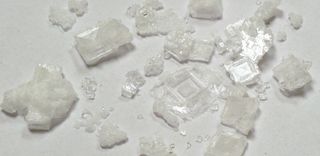
Scientists Make Exotic Chemicals from Salt, Rewrite Textbooks

This article was originally published at The Conversation. The publication contributed the article to LiveScience's Expert Voices: Op-Ed & Insights.
Everything around you is made of elements that scientists have studied in quite some detail over the last 200 years. But all that understanding breaks down when these elements are subjected to high pressure and temperature. Now, using an advanced theoretical understanding and extreme conditions, researchers have converted table salt into exotic chemicals.
Salt is made from one part sodium and one part chlorine. If somehow salt were transported to the centre of the Earth, where the pressure is three million times that on the surface, its crystalline structure would change but the ratio of those two elements would remain the same.
Vitali Prakapenka at the University of Chicago and his colleagues wanted to find out what happens if there were an excess of either sodium or chlorine at such high pressures. Would the ratio between the elements change? “It might,” said Prakapenka, “because chemistry completely changes in such conditions.” If it did, the result would not just be formation of a new compound, but a serious revision of what we think about chemistry.
Elemental behaviour changes at such high pressures. For example, molecules of oxygen, which normally contain two atoms, break down at increased pressures, and the element forms an eight-atom box. Raise the pressure some more to about 300,000 atmospheres, and it starts to superconduct. Chemists are trying to develop chemicals that exhibit similar properties but are stable under normal conditions – learning about these exotic compounds can help them achieve that goal.
Sodium chloride (ie table salt) is a different beast. It is bound in a one-to-one ratio by very strong ionic bonds. However, calculations done by Prakapenka’s colleague Artem Organov at the State University of New York in Stony Brook indicated that even sodium chloride could be twisted to produce exotic chemicals. Those calculations, just published in the journal Science, gave them precise pressures at which, in presence of excess sodium or chlorine, salt could be transformed.
The calculations indicated that NaCl3, Na3Cl, Na2Cl, Na3Cl2, and NaCl7 could all be stable at pressures ranging from 20GPa to 142GPa, where 1GPa is about 10,000 atmospheres of pressure. High pressure physicists have many models to predict behaviour of elements under extreme conditions, but rarely do those models agree with experiment.
Sign up for the Live Science daily newsletter now
Get the world’s most fascinating discoveries delivered straight to your inbox.
Remarkably their calculations stood the test of experiment in at least two cases: Na3Cl and NaCl3. To run such an experiment, you need a fancy device called the diamond anvil cell. Chemicals are added between two diamonds, which can be compressed to produce pressures up to 300GPa. This is what Prakapenka’s colleague used to make Na3Cl and NaCl3, structures that were verified by Prakapenka using X-ray analysis.
“Nobody thought this could happen, given how strong the bond is between sodium and chlorine,” said Prakapenka. “What we have shown is that theory can be translated into experiment, which doesn’t happen often in high pressure physics.”
Malcolm McMahon, professor of high pressure physics at the University of Edinburgh, said, “These are surprising results, and they are guided by remarkable theoretical predictions. Without tools like the ones they have built, we would not have been able to think that sodium chloride could be transformed this way.”
There may not be any immediate application for these results. Instead, the researchers have opened the doors for scientists to start probing other chemicals in the hope of making exotic combinations that can remain stable at room temperature. Diamonds are a good example of that. In nature, they are formed deep inside the Earth when carbon is subjected to extreme pressure. Once formed, they remain stable even at ambient conditions. So there may be other diamond-like materials that we can make, ones that our current understanding of chemistry hasn’t even predicted could exist.
Other implications are non-terrestrial. Each planet in our Solar System and beyond has a lot of material held at extreme pressures. For example, Jupiter is predicted to have metallic hydrogen, where hydrogen’s electrons are free to move as they please. This material is expected to be a superconductor at room temperature. Understanding how chemicals we know about behave in those conditions would be vital to predicting the conditions in the host of exoplanets we are discovering.
If nothing else, Prakapenka’s work shows that even something as simple as table salt can be successfully transformed – meaning we still have much to discover about the elements that we all know (and some of us love).
This article was originally published at The Conversation. Read the original article. The views expressed are those of the author and do not necessarily reflect the views of the publisher. This version of the article was originally published on LiveScience.
Most Popular

